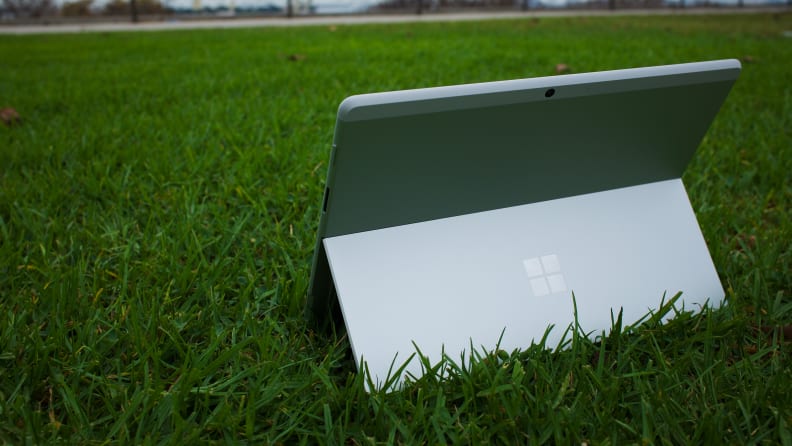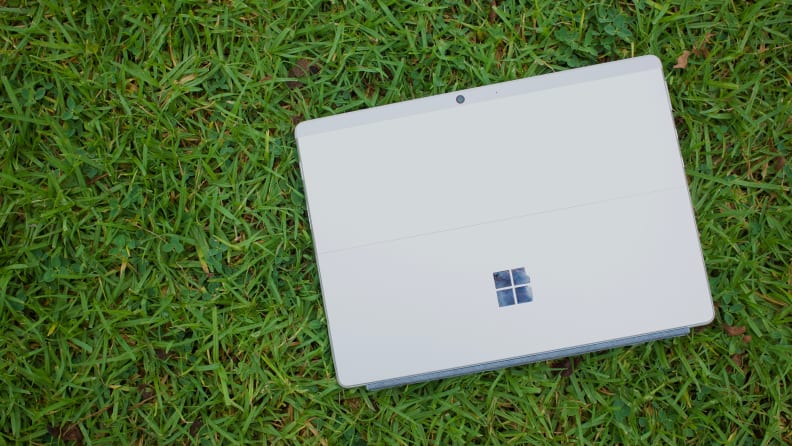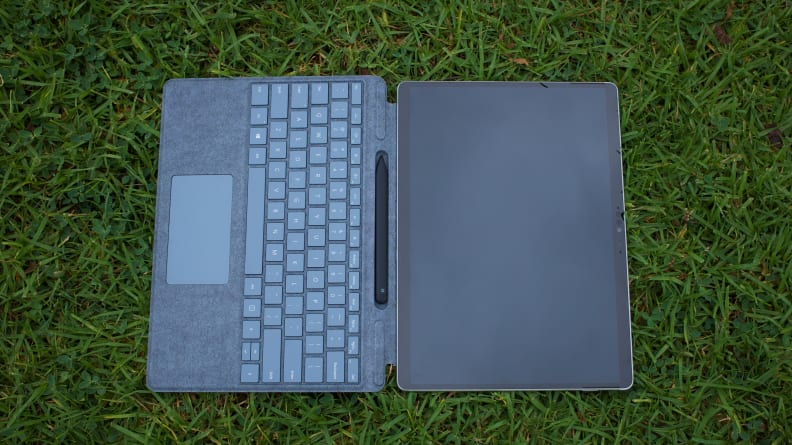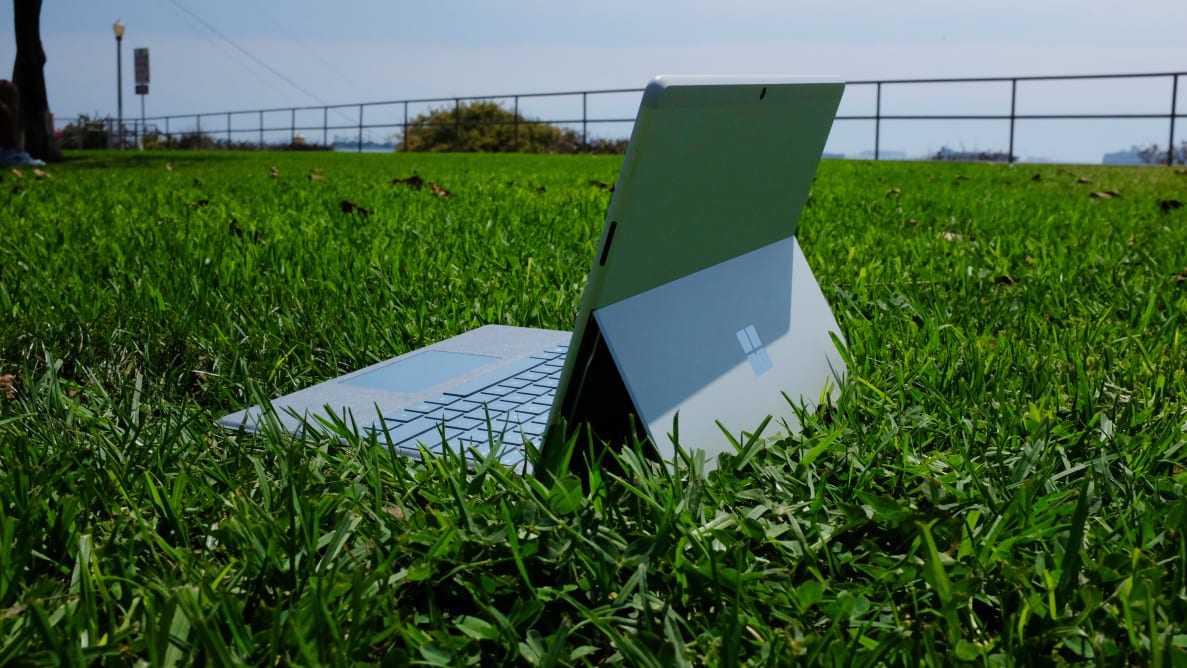Pros
-
Gorgeous, lightweight design
-
Windows Hello is impressively fast
-
Solid battery life
Cons
-
App compatibility is disappointing
-
Accessories cost extra
-
Google Chrome runs slow
About the Microsoft Surface Pro X
Here are the specs of the model we tested:
- Processor: Microsoft SQ2 ARM
- Graphics: SQ2 Adreno 690 GPU
- RAM: 16GB
- Storage: 256GB SSD
- Display: 13” 2880 x 1920 (3:2 aspect ratio)
- Wireless connectivity: Wi-Fi 5: 802.11ac, Qualcomm Snapdragon X24 LTE modem
- Webcam: 5.0MP front-facing camera
- Battery: Up to 15 hours of “typical usage”
- Weight: 1.7 lbs
Our review unit is a top-of-the-line Surface Pro X model, but you can opt for a slightly slower processor and integrated graphics, Microsoft’s SQ1 Adreno 685. Storage sizes come in 128GB, 256GB, and 512GB SSD options, and 16GB of memory is the maximum amount of RAM you can get. The Surface Pro X also comes in two colors, Platinum and Matte Black.
What we like
Gorgeous, lightweight design

The Surface Pro X's kickstand is sturdy and provides plenty of viewing angles to suit your needs.
The Surface Pro X looks pretty similar to other Microsoft Surfaces at first glance: it's a big slab of glass with a 3:2 aspect ratio and a nifty kickstand on the back to hold itself up. There are a few key differences, though, that makes the Pro X look slightly more refined. Its edges are more rounded, and its bezels are thinner than on the Surface Pro 7. They're minor changes, but they give the Pro X a sleeker, more distinguished look.
It's also incredibly light. At just 1.7 pounds (without the Type Cover attached), it's a bit heavier than the 12.9-inch iPad Pro, but that's without Apple's Magic Keyboard attached. Once you latch a keyboard onto each tablet, the Surface Pro X comes out slightly ahead at a total of 2.38 pounds, which is significantly lighter than the iPad Pro with Magic Keyboard's 3.0 pounds.
The Type Cover works great, too. If you're familiar with the Surface Pro's traditional covers, it's pretty much the exact same thing: it attaches to the bottom of the Surface via a strip of magnets and can be positioned at two different angles for your preferred typing experience. The keyboard itself is spacious, and its keys have enough depth to help prevent discomfort over long typing sessions. There's even a slot above the keys to hold your stylus in place, should you choose to snag one.
Windows Hello Sign-In is impressively fast
Like many Windows computers, you can sign into the Surface Pro X using Windows Hello facial recognition. Once it's set up (which only takes a few minutes), you should be able to bypass entering your password every time you flip open your Surface, as long as the webcam and infrared sensors can recognize your face. It works well, even in poorly-lit rooms, and it's surprisingly fast.
There's one caveat, though. Since the Surface Pro X uses a kickstand rather than a traditional laptop hinge for angle adjustment, it's a bit more difficult to reposition the screen once placed on a surface. So, if you're trying to use Windows Hello from a funky angle, your face might not register, and it's a bit less convenient to fix than on something like the MSI Prestige Evo 14. That said, this only happened once or twice over the course of a week's testing.
Solid battery life

The latest Surface Pro X comes in both platinum and matte black options.
To test the Surface Pro X's battery we set the display as close to 200 nits as we could, charged the battery to 100%, and cycled it through a series of websites until the battery drained completely.
With a battery life of just under ten hours in our tests, it's not as impressive as Apple's ARM-powered MacBooks, and it's only slightly better than the results we've received from laptops like HP's Envy x360 15. It'll be enough to get you through a day's worth of notetaking, web browsing, or typing away in docs and spreadsheets, but it's also not that much better than HP's Spectre 14t, which isn’t burdened with the Pro X's app compatibility issue.
What we don't like
You’ll pay extra for accessories
If you want the latest Surface Pro X model you'll have to dish out at least $1,500. That'll get you the model with 256GB of storage, 16GB of RAM, and a tablet without a keyboard or stylus. Those will cost you an additional $140 and $108, respectively. You can use the Surface without either, but you'll be missing out on some key functionalities.
Pair that with an inability to run a large chunk of Windows programs, and the Surface Pro X feels limited. When programs run, they run fairly well, but many don't, and that's a big sacrifice to make for a computer that can cost nearly $2,000, especially when there are equally capable laptops and 2-in-1's that cost significantly less.
Many apps run slow or don't work on ARM

Although it can be used without the Type Cover or stylus, it's best used with at least the keyboard, but that will cost you extra.
Over the course of a week using the Surface Pro X, the biggest frustration we continually ran into was its inability to run a number of apps. While Microsoft's SQ2 ARM chip handles first-party apps like the Office Suite and Edge adequately, third-party programs like Spotify and Chrome can lag. For instance, loading webpages in Chrome takes a few extra seconds compared to Apple’s M1 MacBook Air.
To test browser performance, we ran Basemark's Web 3.0 test, which cycles through a variety of stress tests to see how your computer holds up. When we ran it in Microsoft's Edge browser on the Surface Pro X, it got a score of 523.83. By comparison, the same test returned a score of 300.54 when run in Google Chrome.
That may not be a huge deal, since most Chrome extensions will run perfectly fine within Edge. It strikes at one of the larger issues of the Surface Pro X, though: unless the app has been tailor-made to run on Microsoft's ARM chip, it won't run as well as it could. (Although playing games on a cloud gaming app like Nvidia’s GeForce Now in Chrome works spectacularly well, even with a longer loading time.)
For many other programs, the scenario is even worse. Many apps meant for x86 chips—or rather Intel and AMD processors—won't run at all on the Surface Pro X. Microsoft introduced some programs to make it easier for developers to make their apps compatible with the new chip, but adoption has been slow. There's an x64 app emulator available to Windows Insiders right now, but it's still not widely available.
Slack's desktop app runs particularly slow on the Surface Pro X. It's slower to boot than on Apple's M1 MacBook Air, though it works fairly well in the Edge browser. It's not a dealbreaker if you're fine working within your browser, but it's a sacrifice many computers wouldn't require you to make in the first place, especially at such a high price tag.
This is frustrating given how well Apple's impressive Rosetta 2 emulator works on ARM Macs right. It takes programs that haven't been adapted to Apple's M1 architecture and makes it so the chip can still run the app without any hiccups. While some apps don't run perfectly, it's hardly noticeable in day-to-day use and most apps run well, even games that can run on the x86 version of macOS, like Shadow of the Tomb Raider, have decent performance. Hopefully, Microsoft's emulator will reach that level eventually, but it has a long way to go.
Should you buy it?
No, you can get more for your money elsewhere

The Surface Pro X is a fine tablet, but it's really best experienced with the Type Cover and Surface Pen.
There's a lot to love about the Surface Pro X: it's a lightweight 2-in-1 with a great design, and can easily get you through a day's work with plenty of battery life to spare. All that juice might go to waste, though, unless all the apps you use and rely on will run on Microsoft's ARM chip. For most people, that won't be the case, which makes the Surface Pro X a tough sell.
For students who like taking notes, there's the cheaper and equally powerful iPad Air that starts at just $500. Illustrators who prefer Photoshop to Procreate can still nab a Surface Pro 7 for less than half the price of the $1,500 Pro X to get the job done, and HP's Spectre 14t is $300 cheaper and doesn't require additional accessories for full functionality.
While the Surface Pro X delivers on the promise of a powerful, lightweight convertible tablet with a premium feel, that's only true when things run smoothly. Too often, apps run poorly or not at all. That, along with the Pro X's high price tag, makes it a difficult sell when there are so many other great computers that offer nearly the same experience without the sacrifices.
Meet the tester

Jordan McMahon
Staff Writer, Electronics
Jordan has been writing about and reviewing technology since 2017, with products ranging from tablets and apps to fanny packs and home office gear.
Checking our work.
Our team is here to help you buy the best stuff and love what you own. Our writers, editors, and experts obsess over the products we cover to make sure you're confident and satisfied. Have a different opinion about something we recommend? Email us and we'll compare notes.
Shoot us an email


